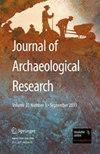In Search of Middle Preclassic Lowland Maya Ideologies
IF 4.1
1区 历史学
Q1 ANTHROPOLOGY
引用次数: 9
Abstract
Little is known about Middle Preclassic/Formative lowland Maya belief systems or ideologies, compared to later periods, but with increasing research at Middle Preclassic sites and recognition of their nascent complexity, this topic merits investigation. Belief systems are investigated through perspectives on materialization (of ideological concepts); on order, legitimacy, and wealth; and on cooperation drawn from collective/corporate action theory and costly signaling (selectionist) theory. Early lowland belief systems are partially outgrowths of Archaic period hunter-gatherer, “tribal” lifeways, and some concepts about cosmology and supernatural forces may be pan-Mesoamerican and pan-New World (e.g., quadripartition; animacy of objects). The best-known early Mesoamerican belief system is that of the Early and Middle Formative Gulf Coast Olmecs and related peoples (especially in Oaxaca) beginning around 1700 BC or so. Middle Preclassic lowland Maya ideologies (considered primarily in terms of power relations) are examined and compared with those of the Olmecs in four material domains: site plans, landscapes, and architecture; sculpture; portable material culture; and iconography. Comparisons reveal significant differences between Maya and Olmec, visible in Olmec materializations of leaders’ power: massive sculptures and exotic goods (costly signaling). Early Maya ideology and concepts of order (including cooperation) and legitimacy (including corporate political strategies) were rooted in beliefs and myths about the creation of the world and its creatures (including humans), about cosmic renewal (especially solar movements), and about time.寻找中前古典低地玛雅意识形态
与后来的时期相比,人们对中期前古典/形成期低地玛雅人的信仰体系或意识形态知之甚少,但随着对中期前古典遗址的研究越来越多,人们认识到它们的新生复杂性,这个话题值得研究。信仰系统通过物化(意识形态概念)的角度进行调查;关于秩序、合法性和财富;以及来自集体/公司行为理论和代价信号(选择主义)理论的合作。早期低地信仰体系部分是古代狩猎采集者、“部落”生活方式的产物,一些关于宇宙学和超自然力量的概念可能是泛中美洲和泛新世界的(例如,四方分割;物体的生命力)。最著名的早期中美洲信仰体系是早期和中期形成的墨西哥湾沿岸奥尔梅克人和相关民族(特别是在瓦哈卡),大约始于公元前1700年左右。前古典时期中期低地玛雅人的意识形态(主要考虑权力关系)在四个材料领域进行了检查和比较:场地规划,景观和建筑;雕塑;便携式物质培养;和形象。对比揭示了玛雅人和奥尔梅克人之间的显著差异,从奥尔梅克人对领导者权力的物质化体现可见:巨大的雕塑和异国情调的商品(昂贵的信号)。早期玛雅人的意识形态和秩序(包括合作)和合法性(包括企业政治战略)的概念根植于关于世界及其生物(包括人类)的创造、关于宇宙更新(尤其是太阳运动)和关于时间的信仰和神话。
本文章由计算机程序翻译,如有差异,请以英文原文为准。
求助全文
约1分钟内获得全文
求助全文
来源期刊

Journal of Archaeological Research
Multiple-
CiteScore
10.20
自引率
7.90%
发文量
9
期刊介绍:
Journal of Archaeological Research publishes the most recent international research summaries on a broad range of topics and geographical areas. The articles are intended to present the current state-of-the-discipline in regard to a particular geographic area or specific research topic or theme. This authoritative review journal improves access to the growing body of information and literature through the publication of original critical articles, each in a 25-40 page format.2-Year Impact Factor: 4.056 (2017) 5-Year Impact Factor: 4.512 (2017)2 out of 85 on the Anthropology listIncluded in the European Reference Index for the Humanities (ERIH) PLUS The European Reference Index for the Humanities and the Social Sciences (ERIH PLUS) was created and developed by European researchers under the coordination of the Standing Committee for the Humanities (SCH) of the European Science Foundation (ESF). https://dbh.nsd.uib.no/publiseringskanaler/erihplus/about/indexSCImago Journal and Country Rank (SJR) 2018: 1.7102 out of 263 on the Archeology (Arts and Humanities) list3 out of 254 on the Archeology list2 out of 131 on the General Arts and Humanities listSJR is a measure of the journal’s relative impact in its field, based on its number of citations and number of articles per publication year.Source Normalised Impact per Paper (SNIP) 2018: 2.112The SNIP measures contextual citation impact by weighting citations based on the total number of citations in a subject field. The impact of a single citation is given higher value in subject areas where citations are less likely, and vice versa.CiteScore 2018: 3.86Rated ''A'' in the Australian Research Council Humanities and Creative Arts Journal List. For more information, visit: http://www.arc.gov.au/era/journal_list.htm
SCImago Journal and Country Rank (SJR) 2011 1.227 Archeology 1 out of 96 Archeology (Arts and Humanities) 1 out of 59 Arts and Humanities (miscellaneous) 1 out of 243
 求助内容:
求助内容: 应助结果提醒方式:
应助结果提醒方式:


